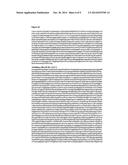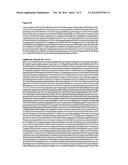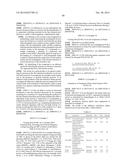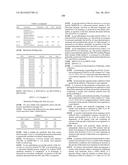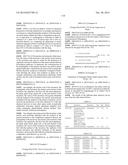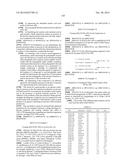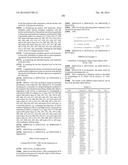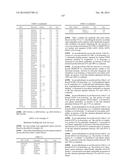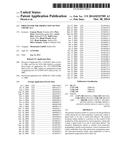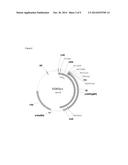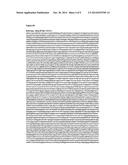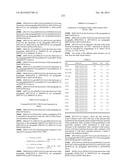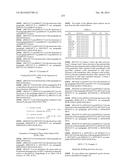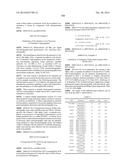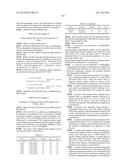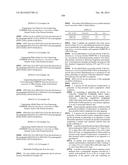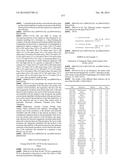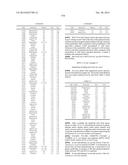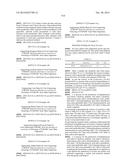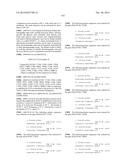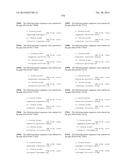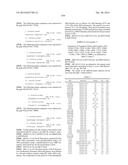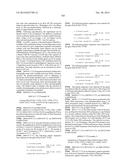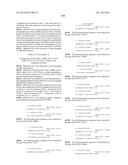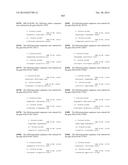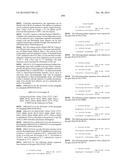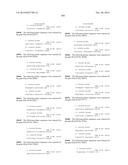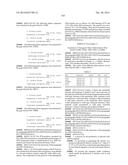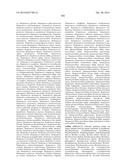Patent application title: PROCESS FOR THE PRODUCTION OF FINE CHEMICALS
Inventors:
Gunnar Plesch (Potsdam, DE)
Piotr Puzio (Mariakerke (gent), BE)
Piotr Puzio (Mariakerke (gent), BE)
Astrid Blau (Stahnsdorf, DE)
Astrid Blau (Stahnsdorf, DE)
Ralf Looser (Berlin, DE)
Ralf Looser (Berlin, DE)
Birgit Wendel (Berlin, DE)
Birgit Wendel (Berlin, DE)
Beate Kamlage (Berlin, DE)
Beate Kamlage (Berlin, DE)
Oliver Schmitz (Dallgow-Doberitz, DE)
Assignees:
Metanomics GmbH
IPC8 Class: AC12P100FI
USPC Class:
800298
Class name: Multicellular living organisms and unmodified parts thereof and related processes plant, seedling, plant seed, or plant part, per se higher plant, seedling, plant seed, or plant part (i.e., angiosperms or gymnosperms)
Publication date: 2014-10-30
Patent application number: 20140325709
Abstract:
The present invention relates to a process for the production of fine
chemicals in a microorganism, a plant cell, a plant, a plant tissue or in
one or more parts thereof. The present invention relates further to a
process for the control of the production of fine chemicals in a
microorganism, a plant cell, a plant, a plant tissue or in one or more
parts thereof. The invention furthermore relates to nucleic acid
molecules, polypeptides, nucleic acid constructs, vectors, antisense
molecules, antibodies, host cells, plant tissue, propagation material,
harvested material, plants, microorganisms as well as agricultural
compositions and to their use.Claims:
1. A process for the production of a fine chemical as indicated in Table
II and/or XII, column 6, which comprises (a) increasing or generating the
activity of a protein as indicated in Table II and/or XII, application
no. 0 to 45, columns 5 or 7, or a functional equivalent thereof in a
non-human organism, or in one or more parts thereof; and (b) growing the
organism under conditions which permit the production of the respective
fine chemical in said organism.
2. A process for the production of a fine chemical as indicated in Table II and/or XII, column 6, comprising increasing or generating in an organism or a part thereof the expression of at least one nucleic acid molecule comprising a nucleic acid molecule selected from the group consisting of: a) a nucleic acid molecule encoding a polypeptide as indicated in Table II and/or XII, application no. 0 to 45, columns 5 or 7, or a fragment thereof, which confers an increase in the amount of the respective fine chemical in an organism or a part thereof; b) a nucleic acid molecule comprising a nucleic acid molecule as indicated in Table I and/or XI, application no. 0 to 45, columns 5 or 7; c) a nucleic acid molecule whose sequence can be deduced from a polypeptide sequence encoded by a nucleic acid molecule of (a) or (b) as a result of the degeneracy of the genetic code and conferring an increase in the amount of the respective fine chemical in an organism or a part thereof; d) a nucleic acid molecule which encodes a polypeptide which has at least 90% identity with the amino acid sequence of the polypeptide encoded by the nucleic acid molecule of (a) to (c) and conferring an increase in the amount of the respective fine chemical in an organism or a part thereof; e) a nucleic acid molecule which hybridizes with a nucleic acid molecule of (a) to (c) under stringent hybridization conditions and conferring an increase in the amount of the respective fine chemical in an organism or a part thereof; f) a nucleic acid molecule which encompasses a nucleic acid molecule which is obtained by amplifying nucleic acid molecules from a cDNA library or a genomic library using the primers or primer pairs as indicated in Table III and/or XIII, application no. 0 to 45, columns 7, and conferring an increase in the amount of the respective fine chemical in an organism or a part thereof; g) a nucleic acid molecule encoding a polypeptide which is isolated with the aid of monoclonal antibodies against a polypeptide encoded by one of the nucleic acid molecules of (a) to (f) and conferring an increase in the amount of the respective fine chemical in an organism or a part thereof; h) a nucleic acid molecule encoding a polypeptide comprising a consensus sequence as indicated in Table IV and/or XIV, application no. 0 to 45, columns 7, and conferring an increase in the amount of the respective fine chemical in an organism or a part thereof; and i) a nucleic acid molecule which is obtainable by screening a suitable nucleic acid library under stringent hybridization conditions with a probe comprising one of the sequences of the nucleic acid molecule of (a) to (h) or with a fragment thereof having at least 15 nt, preferably 20 nt, 30 nt, 50 nt, 100 nt, 200 nt or 500 nt of the nucleic acid molecule characterized in (a) to (k) and conferring an increase in the amount of the respective fine chemical in an organism or a part thereof. or comprising a sequence which is complementary thereto.
3. The process of claim 1, comprising recovering the free or bound respective fine chemical.
4. The process of claim 2, comprising the following steps: (a) selecting an organism or a part thereof expressing a polypeptide encoded by the nucleic acid molecule characterized in claim 2; (b) mutagenizing the selected organism or the part thereof; (c) comparing the activity or the expression level of said polypeptide in the mutagenized organism or the part thereof with the activity or the expression of said polypeptide of the selected organisms or the part thereof; (d) selecting the mutated organisms or parts thereof, which comprise an increased activity or expression level of said polypeptide compared to the selected organism or the part thereof; (e) optionally, growing and cultivating the organisms or the parts thereof; and (f) recovering, and optionally isolating, the free or bound respective fine chemical produced by the selected mutated organisms or parts thereof.
5. The process of claim 2, wherein the expression of said nucleic acid molecule is increased or generated transiently or stably.
6. An isolated nucleic acid molecule comprising a nucleic acid molecule selected from the group consisting of: a) a nucleic acid molecule encoding a polypeptide as indicated in Table II and/or XII, application no. 0 to 45, columns 5 or 7, or a fragment thereof, which confers an increase in the amount of the respective fine chemical as indicated in the corresponding column 6 in an organism or a part thereof; b) a nucleic acid molecule comprising a nucleic acid molecule as indicated in Table I and/or XI, application no. 0 to 45, columns 5 or 7; c) a nucleic acid molecule whose sequence can be deduced from a polypeptide sequence encoded by a nucleic acid molecule of (a) or (b) as a result of the degeneracy of the genetic code and conferring an increase in the amount of the respective fine chemical in an organism or a part thereof; d) a nucleic acid molecule which encodes a polypeptide which has at least 90% identity with the amino acid sequence of the polypeptide encoded by the nucleic acid molecule of (a) to (c) and conferring an increase in the amount of the respective fine chemical in an organism or a part thereof; e) a nucleic acid molecule which hybridizes with a nucleic acid molecule of (a) to (c) under stringent hybridization conditions and conferring an increase in the amount of the respective fine chemical in an organism or a part thereof; f) a nucleic acid molecule which encompasses a nucleic acid molecule which is obtained by amplifying nucleic acid molecules from a cDNA library or a genomic library using the primers or primer pairs as indicated in Table III and/or XIII, application no. 0 to 45, columns 7, and conferring an increase in the amount of the respective fine chemical in an organism or a part thereof; g) a nucleic acid molecule encoding a polypeptide which is isolated with the aid of monoclonal antibodies against a polypeptide encoded by one of the nucleic acid molecules of (a) to (f) and conferring an increase in the amount of the respective fine chemical in an organism or a part thereof; h) a nucleic acid molecule encoding a polypeptide comprising a consensus sequence as indicated in Table IV and/or XIV, application no. 0 to 45, columns 7, and conferring an increase in the amount of the respective fine chemical in an organism or a part thereof; and i) a nucleic acid molecule which is obtainable by screening a suitable nucleic acid library under stringent hybridization conditions with a probe comprising one of the sequences of the nucleic acid molecule of (a) to (h) or with a fragment thereof having at least 15 nt, preferably 20 nt, 30 nt, 50 nt, 100 nt, 200 nt or 500 nt of the nucleic acid molecule characterized in (a) to (h) and conferring an increase in the amount of the respective fine chemical in an organism or a part thereof, whereby the nucleic acid molecule distinguishes over the sequence as indicated in Table I and/or XI, application no. 0 to 45, columns 5 or 7, by one or more nucleotides.
7. An isolated nucleic acid molecule comprising a nucleic acid molecule selected from the group of nucleic acid molecules as defined in claim 2 part a) to i).
8. A nucleic acid construct which confers the expression of the nucleic acid molecule of claim 6, comprising one or more regulatory elements.
9. A nucleic acid construct which confers the expression of the nucleic acid molecule of claim 7, comprising one or more regulatory elements.
10. A vector comprising the nucleic acid molecule as claimed in claim 6.
11. A vector comprising the nucleic acid molecule as claimed in claim 7.
12. A host cell, which has been transformed stably or transiently with the nucleic acid molecule as claimed in claim 6.
13. A host cell, which has been transformed stably or transiently with the nucleic acid molecule as claimed in claim 7.
14. A process for producing a polypeptide, comprising expressing the polypeptide in a host cell as claimed in claim 12.
15. A process for producing a polypeptide, comprising expressing the polypeptide in a host cell as claimed in claim 13.
16. A polypeptide encoded by the nucleic acid molecule as claimed in claim 6 whereby the polypeptide distinguishes over a sequence as indicated in Table II and/or XII, application no. 0 to 45, columns 5 or 7, by one or more amino acids.
17. A polypeptide encoded by the nucleic acid molecule as claimed in claim 7.
18. An antibody, which binds specifically to the polypeptide as claimed in claim 16.
19. An antibody, which binds specifically to the polypeptide as claimed in claim 17.
20. A plant tissue, propagation material, harvested material or a plant comprising the host cell as claimed in claim 12 wherein the host cell is a plant cell or an Agrobacterium.
21. A plant tissue, propagation material, harvested material or a plant comprising the host cell as claimed in claim 13 wherein the host cell is a plant cell or an Agrobacterium.
22. A method for screening for agonists and antagonists of the activity of a polypeptide encoded by the nucleic acid molecule of claim 6 conferring an increase in the amount of the respective fine chemical in an organism or a part thereof comprising: (a) contacting cells, tissues, plants or microorganisms which express the polypeptide encoded by the nucleic acid molecule of claim 6 conferring an increase in the amount of the respective fine chemical in an organism or a part thereof with a candidate compound or a sample comprising a plurality of compounds under conditions which permit the expression of the polypeptide; (b) assaying the respective fine chemical level or the polypeptide expression level in the cell, tissue, plant or microorganism or the media the cell, tissue, plant or microorganisms is cultured or maintained in; and (c) identifying an agonist or antagonist by comparing the measured fine chemical level or polypeptide expression level with a standard fine chemical or polypeptide expression level measured in the absence of said candidate compound or a sample comprising said plurality of compounds, whereby an increased level over the standard indicates that the compound or the sample comprising said plurality of compounds is an agonist and a decreased level over the standard indicates that the compound or the sample comprising said plurality of compounds is an antagonist.
23. A method for screening for agonists and antagonists of the activity of a polypeptide encoded by the nucleic acid molecule of claim 7 conferring an increase in the amount of the respective fine chemical in an organism or a part thereof comprising: (a) contacting cells, tissues, plants or microorganisms which express the polypeptide encoded by the nucleic acid molecule of claim 7 conferring an increase in the amount of the respective fine chemical in an organism or a part thereof with a candidate compound or a sample comprising a plurality of compounds under conditions which permit the expression of the polypeptide; (b) assaying the respective fine chemical level or the polypeptide expression level in the cell, tissue, plant or microorganism or the media the cell, tissue, plant or microorganisms is cultured or maintained in; and (c) identifying an agonist or antagonist by comparing the measured fine chemical level or polypeptide expression level with a standard fine chemical or polypeptide expression level measured in the absence of said candidate compound or a sample comprising said plurality of compounds, whereby an increased level over the standard indicates that the compound or the sample comprising said plurality of compounds is an agonist and a decreased level over the standard indicates that the compound or the sample comprising said plurality of compounds is an antagonist.
24. A process for the identification of a compound conferring increased fine chemical production in a plant or microorganism, comprising the steps: (a) culturing a plant cell or tissue or microorganism or maintaining a plant expressing the polypeptide encoded by the nucleic acid molecule of claim 6 conferring an increase in the amount of the respective fine chemical in an organism or a part thereof and a readout system capable of interacting with the polypeptide under suitable conditions which permit the interaction of the polypeptide with said readout system in the presence of a compound or a sample comprising a plurality of compounds and capable of providing a detectable signal in response to the binding of a compound to said polypeptide under conditions which permit the expression of said readout system and of the polypeptide encoded by the nucleic acid molecule of claim 6 conferring an increase in the amount of the respective fine chemical in an organism or a part thereof; (b) identifying if the compound is an effective agonist by detecting the presence or absence or increase of a signal produced by said readout system.
25. A process for the identification of a compound conferring increased fine chemical production in a plant or microorganism, comprising the steps: (a) culturing a plant cell or tissue or microorganism or maintaining a plant expressing the polypeptide encoded by the nucleic acid molecule of claim 7 conferring an increase in the amount of the respective fine chemical in an organism or a part thereof and a readout system capable of interacting with the polypeptide under suitable conditions which permit the interaction of the polypeptide with said readout system in the presence of a compound or a sample comprising a plurality of compounds and capable of providing a detectable signal in response to the binding of a compound to said polypeptide under conditions which permit the expression of said readout system and of the polypeptide encoded by the nucleic acid molecule of claim 7 conferring an increase in the amount of the respective fine chemical in an organism or a part thereof; (b) identifying if the compound is an effective agonist by detecting the presence or absence or increase of a signal produced by said readout system.
26. A method for the identification of a gene product conferring an increase in the respective fine chemical production in a cell, comprising the following steps: (a) contacting the nucleic acid molecules of a sample, which can contain a candidate gene encoding a gene product conferring an increase in the respective fine chemical after expression with the nucleic acid molecule of claim 6; (b) identifying the nucleic acid molecules, which hybridise under relaxed stringent conditions with the nucleic acid molecule of claim 6; (c) introducing the candidate nucleic acid molecules in host cells appropriate for producing the respective fine chemical; (d) expressing the identified nucleic acid molecules in the host cells; (e) assaying the respective fine chemical level in the host cells; and (f) identifying nucleic acid molecule and its gene product which expression confers an increase in the respective fine chemical level in the host cell after expression compared to the wild type.
27. A method for the identification of a gene product conferring an increase in the respective fine chemical production in a cell, comprising the following steps: (a) contacting the nucleic acid molecules of a sample, which can contain a candidate gene encoding a gene product conferring an increase in the respective fine chemical after expression with the nucleic acid molecule of claim 7; (b) identifying the nucleic acid molecules, which hybridise under relaxed stringent conditions with the nucleic acid molecule of claim 7; (c) introducing the candidate nucleic acid molecules in host cells appropriate for producing the respective fine chemical; (d) expressing the identified nucleic acid molecules in the host cells; (e) assaying the respective fine chemical level in the host cells; and (f) identifying nucleic acid molecule and its gene product which expression confers an increase in the respective fine chemical level in the host cell after expression compared to the wild type.
28. A method for the identification of a gene product conferring an increase in the respective fine chemical production in a cell, comprising the following steps: (a) identifying in a data bank nucleic acid molecules of an organism; which can contain a candidate gene encoding a gene product conferring an increase in the respective fine chemical amount or level in an organism or a part thereof after expression, and which are at least 90% homolog to the nucleic acid molecule of claim 6; (b) introducing the candidate nucleic acid molecules in host cells appropriate for producing the respective fine chemical; (c) expressing the identified nucleic acid molecules in the host cells; (d) assaying the respective fine chemical level in the host cells; and (e) identifying nucleic acid molecule and its gene product which expression confers an increase in the respective fine chemical level in the host cell after expression compared to the wild type.
29. A method for the identification of a gene product conferring an increase in the respective fine chemical production in a cell, comprising the following steps: (a) identifying in a data bank nucleic acid molecules of an organism; which can contain a candidate gene encoding a gene product conferring an increase in the respective fine chemical amount or level in an organism or a part thereof after expression, and which are at least 90% homolog to the nucleic acid molecule of claim 7; (b) introducing the candidate nucleic acid molecules in host cells appropriate for producing the respective fine chemical; (c) expressing the identified nucleic acid molecules in the host cells; (d) assaying the respective fine chemical level in the host cells; and (e) identifying nucleic acid molecule and its gene product which expression confers an increase in the respective fine chemical level in the host cell after expression compared to the wild type.
30. A method for the production of an agricultural composition comprising the steps of the method of claim 24 and formulating the compound identified in claim 24 in a form acceptable for an application in agriculture.
31. A method for the production of an agricultural composition comprising the steps of the method of claim 25 and formulating the compound identified in claim 25 in a form acceptable for an application in agriculture.
32. A composition produced by the method of claim 30, wherein the composition is a food or feed composition.
33. A composition produced by the method of claim 31, wherein the composition is a food or feed composition.
34. A process for the control of the production of fine chemicals comprising (a) increasing or generating the activity of one or more b0019, b0050, b0057, b0112, b0124, b0138, b0149, b0161, b0175, b0196, b0251, b0252, b0255, b0376, b0462, b0464, b0486, b0577, b0651, b0695, b0730, b0828, b0847, b0849, b0880, b0970, b0986, b1097, b1284, b1318, b1343, b1360, b1463, b1693, b1708, b1736, b1738, b1829, b1886, b1896, b1926, b1961, b2023, b2078, b2095, b2211, b2239, b2307, b2414, b2426, b2478, b2489, b2491, b2507, b2553, b2576, b2597, b2599, b2664, b2699, b2703, b2710, b2753, b2796, b2822, b3064, b3074, b3116, b3129, b3160, b3166, b3169, b3172, b3231, b3256, b3260, b3430, b3457, b3462, b3578, b3619, b3644, b3684, b3767, b3791, b3919, b3926, b3936, b3938, b3966, b3983, b4004, b4054, b4063, b4074, b4122, b4129, b4139, b4232, b4239, b4327, b4346, b4401, YAL049C, YBL015W, YBR084W, YBR089C-A, YBR184W, YBR204C, YCL038C, YCR012W, YCR059C, YDL127W, YDR271C, YDR316W, YDR447C, YDR513W, YEL045C, YEL046C, YER152C, YER156C, YER173W, YER174C, YFL019C, YFL050C, YFL053W, YFR007W, YFR042W, YGL205W, YGL237C, YGR101W, YGR104C, YGR261C, YHR072W, YHR072W-A, YHR130C, YHR189W, YHR201C, YIL150C, YJL055W, YJL072C, YJL099W, YKL132C, YKR057W, YLL013C, YLR082C, YLR089C, YLR224W, YLR255C, YLR375W, YOR024W, YOR044W, YOR084W, YOR245C, YOR317W, YOR344C, YOR350C, YPL099C, YPL268W, YPRO24W, YPR138C and/or YPR172W and/or b0021, b0043, b0134, b0186, b0186, b0328, b0677, b0734, b0763, b0895, b0895, b1054, b1183, b1217, b1249, b1292, b1874, b2110, b2696, b2901, b3025, b3091, b3335, b3709, b3825, b3924, b4101, b4113, b4242, b4359, YGL005C and/or YML005W protein(s) or homologs thereof, having the sequence of a polypeptide encoded by a corresponding nucleic acid molecule indicated in Table I, columns 5 or 7 or indicated in Table V columns 5 or 7, in a non-human organism or in one or more parts thereof; and (b) growing the organism under conditions which permit the production of the fine chemical in said organism in a metabolic profile as indicated in Table X and/or IX, wherein, in the metabolic profile, a numerical value greater than "1" represents an increase of a metabolite content and a numerical value less than "1" represents a decrease of a metabolite content compared to the wild type cell, microorganism, plant cell, plant, plant tissue or one or more parts thereof, and no number in Table X means a numerical value of "1" concerning the metabolite profile which is essentially identical to the metabolite profile of the wild type.
35. A process for the control of the production of fine chemicals comprising (a) increasing or generating the activity of one or more b0019, b0050, b0057, b0112, b0124, b0138, b0149, b0161, b0175, b0196, b0251, b0252, b0255, b0376, b0462, b0464, b0486, b0577, b0651, b0695, b0730, b0828, b0847, b0849, b0880, b0970, b0986, b1097, b1284, b1318, b1343, b1360, b1463, b1693, b1708, b1736, b1738, b1829, b1886, b1896, b1926, b1961, b2023, b2078, b2095, b2211, b2239, b2307, b2414, b2426, b2478, b2489, b2491, b2507, b2553, b2576, b2597, b2599, b2664, b2699, b2703, b2710, b2753, b2796, b2822, b3064, b3074, b3116, b3129, b3160, b3166, b3169, b3172, b3231, b3256, b3260, b3430, b3457, b3462, b3578, b3619, b3644, b3684, b3767, b3791, b3919, b3926, b3936, b3938, b3966, b3983, b4004, b4054, b4063, b4074, b4122, b4129, b4139, b4232, b4239, b4327, b4346, b4401, YAL049C, YBL015W, YBR084W, YBR089C-A, YBR184W, YBR204C, YCL038C, YCR012W, YCR059C, YDL127W, YDR271C, YDR316W, YDR447C, YDR513W, YEL045C, YEL046C, YER152C, YER156C, YER173W, YER174C, YFL019C, YFL050C, YFL053W, YFR007W, YFR042W, YGL205W, YGL237C, YGR101W, YGR104C, YGR261C, YHR072W, YHR072W-A, YHR130C, YHR189W, YHR201C, YIL150C, YJL055W, YJL072C, YJL099W, YKL132C, YKR057W, YLL013C, YLR082C, YLR089C, YLR224W, YLR255C, YLR375W, YOR024W, YOR044W, YOR084W, YOR245C, YOR317W, YOR344C, YOR350C, YPL099C, YPL268W, YPRO24W, YPR138C and/or YPR172W and/or b0021, b0043, b0134, b0186, b0186, b0328, b0677, b0734, b0763, b0895, b0895, b1054, b1183, b1217, b1249, b1292, b1874, b2110, b2696, b2901, b3025, b3091, b3335, b3709, b3825, b3924, b4101, b4113, b4242, b4359, YGL005C and/or YML005W protein(s) or homologs thereof, having the sequence of a polypeptide encoded by a corresponding nucleic acid molecule indicated in Table I, columns 5 or 7, or indicated in Table V columns 5 or 7, in a non-human organism or in one or more parts thereof and (b) growing the organism under conditions which permit the production of fine chemicals in defined ratios in said organism resulting in a defined metabolic profile.
36. A process for the control of the production of fine chemicals comprising expressing in an organism or a part thereof at least one nucleic acid molecule comprising a nucleic acid molecule selected from the group consisting of: a) a nucleic acid molecule encoding a polypeptide having a sequence as indicated in Table II, columns 5 or 7, or indicated in Table VI, or selected from the group consisting of b0019, b0050, b0057, b0112, b0124, b0138, b0149, b0161, b0175, b0196, b0251, b0252, b0255, b0376, b0462, b0464, b0486, b0577, b0651, b0695, b0730, b0828, b0847, b0849, b0880, b0970, b0986, b1097, b1284, b1318, b1343, b1360, b1463, b1693, b1708, b1736, b1738, b1829, b1886, b1896, b1926, b1961, b2023, b2078, b2095, b2211, b2239, b2307, b2414, b2426, b2478, b2489, b2491, b2507, b2553, b2576, b2597, b2599, b2664, b2699, b2703, b2710, b2753, b2796, b2822, b3064, b3074, b3116, b3129, b3160, b3166, b3169, b3172, b3231, b3256, b3260, b3430, b3457, b3462, b3578, b3619, b3644, b3684, b3767, b3791, b3919, b3926, b3936, b3938, b3966, b3983, b4004, b4054, b4063, b4074, b4122, b4129, b4139, b4232, b4239, b4327, b4346, b4401, YAL049C, YBL015W, YBR084W, YBR089C-A, YBR184W, YBR204C, YCL038C, YCR012W, YCR059C, YDL127W, YDR271C, YDR316W, YDR447C, YDR513W, YEL045C, YEL046C, YER152C, YER156C, YER173W, YER174C, YFL019C, YFL050C, YFL053W, YFR007W, YFR042W, YGL205W, YGL237C, YGR101W, YGR104C, YGR261C, YHR072W, YHR072W-A, YHR130C, YHR189W, YHR201C, YIL150C, YJL055W, YJL072C, YJL099W, YKL132C, YKR057W, YLL013C, YLR082C, YLR089C, YLR224W, YLR255C, YLR375W, YOR024W, YOR044W, YOR084W, YOR245C, YOR317W, YOR344C, YOR350C, YPL099C, YPL268W, YPRO24W, YPR138C and YPR172W and/or b0021, b0043, b0134, b0186, b0186, b0328, b0677, b0734, b0763, b0895, b0895, b1054, b1183, b1217, b1249, b1292, b1874, b2110, b2696, b2901, b3025, b3091, b3335, b3709, b3825, b3924, b4101, b4113, b4242, b4359, YGL005C and/or YML005W, or a fragment thereof, which confers an increase or a decrease in the amount of the respective fine chemical as shown in Table X and/or indicated in Table IX in an organism or a part thereof; b) a nucleic acid molecule comprising a nucleic acid molecule having a sequence as indicated in Table I, columns 5 or 7, and encoding a polypeptide as defined in (a) and named in Table X and/or IX and/or a sequence as indicated in Table V columns 5 or 7, c) a nucleic acid molecule whose sequence can be deduced from a polypeptide sequence encoded by a nucleic acid molecule of (a) or (b) as result of the degeneracy of the genetic code and conferring an increase in the amount of the respective fine chemical in an organism or a part thereof; d) a nucleic acid molecule encoding a polypeptide which has at least 90% identity with the amino acid sequence of the polypeptide encoded by the nucleic acid molecule of (a) to (c) and conferring an increase or decrease in the amount of the respective fine chemical in an organism or a part thereof; e) a nucleic acid molecule which hybridizes with a nucleic acid molecule of (a) to (c) under stringent hybridization conditions and conferring an increase in the amount of the respective fine chemical in an organism or a part thereof; f) a nucleic acid molecule encoding a polypeptide, the polypeptide being derived by substituting, deleting and/or adding one or more amino acids of the amino acid sequence of the polypeptide encoded by the nucleic acid molecules (a) to (d) and conferring an increase or decrease in the amount of the respective fine chemical in an organism or a part thereof; g) a nucleic acid molecule encoding a fragment or an epitope of a polypeptide which is encoded by one of the nucleic acid molecules of (a) to (e) and conferring an increase or decrease in the amount of the respective fine chemical in an organism or a part thereof; h) a nucleic acid molecule comprising a nucleic acid molecule which is obtained by amplifying nucleic acid molecules from a cDNA library or a genomic library using the primers pairs having a sequence as indicated in Table III, columns 7, and corresponding to a polypeptide as defined in (a) and named in Table X and/or IX, and/or primers pairs as indicated in Table VII, and conferring an increase or decrease in the amount of the respective fine chemical in an organism or a part thereof; i) a nucleic acid molecule encoding a polypeptide which is isolated with the aid of monoclonal antibodies against a polypeptide encoded by one of the nucleic acid molecules of (a) to (h) and conferring an increase or decrease in the amount of the respective fine chemical in an organism or a part thereof; j) a nucleic acid molecule which encodes a polypeptide comprising the consensus sequence having a sequences as indicated in Table IV, columns 7, and corresponding to a polypeptide as defined in (a) and named in Table X and/or IX, and/or the consensus sequence having a sequences as indicated in Table VIII, columns 7 and conferring an increase or decrease in the amount of the respective fine chemical in an organism or a part thereof; k) a nucleic acid molecule comprising one or more of the nucleic acid molecules encoding the amino acid sequence of a polypeptide comprising a domain of a polypeptide indicated in Table II, columns 5 or 7, and as defined in (a) and named in Table X, and/or as indicated in Table VI columns 5 or 7, and conferring an increase or decrease in the amount of the respective fine chemical in an organism or a part thereof; and l) a nucleic acid molecule which is obtainable by screening a suitable library under stringent conditions with a probe comprising one of the sequences of the nucleic acid molecule of (a) to (k) or with a fragment of at least 15 nt, preferably 20 nt, 30 nt, 50 nt, 100 nt, 200 nt or 500 nt of the nucleic acid molecule characterized in (a) to (k) and conferring an increase or decrease in the amount of the respective fine chemical in an organism or a part thereof; or which comprises a sequence which is complementary thereto.
37. The process of claim 34, wherein one or more fine chemicals are isolated.
38. A host cell which exhibits a metabolic profile according to any of the column as depicted in Table X and/or to any line as depicted in Table IX.
39. A process for the identification of a compound conferring a metabolic profile as shown in Table X or in Table IX in a cell, plant or microorganism, comprising the steps: (a) culturing a plant cell or tissue or microorganism or maintaining a plant expressing a polypeptide encoded by the nucleic acid molecule of claim 36 a) conferring an increase or decrease in the amount of the respective fine chemicals in an organism or a part thereof and a readout system capable of interacting with the polypeptide under suitable conditions which permit the interaction of the polypeptide with said readout system in the presence of a compound or a sample comprising a plurality of compounds and capable of providing a detectable signal in response to the binding of a compound to said polypeptide under conditions which permit the expression of said readout system and of the polypeptide encoded by the nucleic acid molecule of claim 42 a) conferring an increase or decrease in the amount of the respective fine chemicals in an organism or a part thereof; and (b) identifying if the compound is an effective agonist by detecting the presence or absence or increase of a signal produced by said readout system.
40. A method for the identification of a gene product conferring an increase or decrease in fine chemical production in a cell according to the metabolic profile disclosed in Table X and/or in Table IX, comprising the following steps: (a) contacting the nucleic acid molecules of a sample, which can contain a candidate gene encoding a gene product conferring an increase or decrease in one or more fine chemicals according to Table X and/or Table IX after expression with the nucleic acid molecule of claim 36 a); (b) identifying the nucleic acid molecules, which hybridize under relaxed stringent conditions with the nucleic acid molecule of claim 36 a); (c) introducing the candidate nucleic acid molecules in host cells appropriate for producing one or more fine chemicals according to Table X; (d) expressing the identified nucleic acid molecules in the host cells; (e) assaying the level of one or more fine chemicals according to Table X and/or Table IX in the host cells; and (f) identifying a nucleic acid molecule and its gene product which expression confers an increase or decrease in the level of one or more fine chemicals according to Table X and/or Table IX in the host cell after expression compared to the wild type.
41. A method for the identification of a gene product conferring an increase or decrease in fine chemical production in a cell according to the metabolic profile disclosed in Table X and/or Table IX in a cell, comprising the following steps: (a) identifying in a data bank nucleic acid molecules of an organism; which can contain a candidate gene encoding a gene product conferring an increase or decrease in the level of one or more fine chemicals according to Table X and/or Table IX in an organism or a part thereof after expression, and which are at least 90% homologous to the nucleic acid molecule of claim 42 a); (b) introducing the candidate nucleic acid molecules in host cells appropriate for producing a metabolic profile according to Table X and/or Table IX; (c) expressing the identified nucleic acid molecules in the host cells; (d) assaying the metabolic profile in the host cells; and (e) identifying a nucleic acid molecule and its gene product which expression confers the desired metabolic profile according to Table X and/or Table IX in the host cell after expression compared to the wild type.
42. A process for the production of a composition of fine chemicals comprising (a) increasing or generating the activity of one or more b0019, b0050, b0057, b0112, b0124, b0138, b0149, b0161, b0175, b0196, b0251, b0252, b0255, b0376, b0462, b0464, b0486, b0577, b0651, b0695, b0730, b0828, b0847, b0849, b0880, b0970, b0986, b1097, b1284, b1318, b1343, b1360, b1463, b1693, b1708, b1736, b1738, b1829, b1886, b1896, b1926, b1961, b2023, b2078, b2095, b2211, b2239, b2307, b2414, b2426, b2478, b2489, b2491, b2507, b2553, b2576, b2597, b2599, b2664, b2699, b2703, b2710, b2753, b2796, b2822, b3064, b3074, b3116, b3129, b3160, b3166, b3169, b3172, b3231, b3256, b3260, b3430, b3457, b3462, b3578, b3619, b3644, b3684, b3767, b3791, b3919, b3926, b3936, b3938, b3966, b3983, b4004, b4054, b4063, b4074, b4122, b4129, b4139, b4232, b4239, b4327, b4346, b4401, YAL049C, YBL015W, YBR084W, YBR089C-A, YBR184W, YBR204C, YCL038C, YCR012W, YCR059C, YDL127W, YDR271C, YDR316W, YDR447C, YDR513W, YEL045C, YEL046C, YER152C, YER156C, YER173W, YER174C, YFL019C, YFL050C, YFL053W, YFR007W, YFR042W, YGL205W, YGL237C, YGR101W, YGR104C, YGR261C, YHR072W, YHR072W-A, YHR130C, YHR189W, YHR201C, YIL150C, YJL055W, YJL072C, YJL099W, YKL132C, YKR057W, YLL013C, YLR082C, YLR089C, YLR224W, YLR255C, YLR375W, YOR024W, YOR044W, YOR084W, YOR245C, YOR317W, YOR344C, YOR350C, YPL099C, YPL268W, YPRO24W, YPR138C and/or YPR172W and/or b0021, b0043, b0134, b0186, b0186, b0328, b0677, b0734, b0763, b0895, b0895, b1054, b1183, b1217, b1249, b1292, b1874, b2110, b2696, b2901, b3025, b3091, b3335, b3709, b3825, b3924, b4101, b4113, b4242, b4359, YGL005C and/or YML005W protein(s) or homologs thereof, having the sequence of a polypeptide encoded by a corresponding nucleic acid molecule indicated in Table I, columns 5 or 7 or indicated in Table V columns 5 or 7, in a non-human organism or in one or more parts thereof; and (b) growing the organism under conditions which permit production of a composition of fine chemicals in said organism in a relative ratio as indicated in Table X and/or IX, wherein a numerical value greater than "1" stands for an increase of a metabolite content, a numerical value less than "1" stands for a decrease of a metabolite content, compared to the wild type cell, microorganism, plant cell, plant, plant tissue or one or more parts thereof and no number in Table X means a numerical value of "1" concerning the metabolite profile, which is essentially identical to the metabolite profile of the wild type, wherein said composition is a biological composition.
43. A biological composition of fine chemicals in a defined ratio produced by the process of claim 42.
44. A method of diagnosis of the level of expression of the nucleic acid molecule of claim 36 a) by (a) measuring the metabolic content in a microorganism, a plant cell, a plant, a plant tissue or in one or more parts thereof; and (b) comparing the metabolic content with the relative metabolic profile as depicted in Table X and/or IX.
Description:
User Contributions:
Comment about this patent or add new information about this topic:
| People who visited this patent also read: | |
| Patent application number | Title |
|---|---|
| 20150157402 | ABLATION CATHETER |
| 20150157400 | MEDICAL DEVICE FOR USE IN BODILY LUMENS, FOR EXAMPLE AN ATRIUM |
| 20150157399 | Control handle for a contact force ablation catheter |
| 20150157398 | Methods for Treating Heart Arrhythmia |
| 20150157397 | DEVICES AND METHODS FOR PROSTATE TISSUE ABLATION AND/OR RESECTION |


